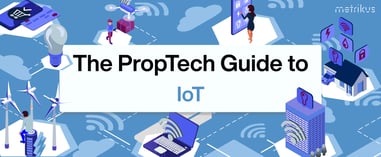5 ways IoT can make your life easier
Thanks to near-ubiquitous wifi accessibility and a wide array of innovations in the tech field, we are living in an increasingly interconnected world. The Internet of Things (IoT) is making everything easier by connecting mobile phones, vehicles, and electronic appliances, all of which collect and exchange data through embedded sensors.
IoT is beginning to find its place in many wider aspects of our lives too, from combating climate change to revolutionising emergency response methods. IoT is still in its infancy, but it is already being incorporated into a variety of products and services that are available today which have been developed with the purpose of making people’s lives easier: we look into the top 5 ways this is happening.
1. Smart offices
Intelligent buildings are currently revolutionising the traditional commercial offices we are used to. Smart offices are highly connected ecosystems that understand workers’ needs, and more than a third of workers are excited about the opportunity to leverage IoT to wirelessly connect devices and analyse data in real time.
IoT innovations within the realms of building controls and automation have made life easier for the occupants of smart offices, as well as the building owners and facility managers. IoT-enabled analytics also allow occupants to control environmental conditions within their offices, improving general comfort, satisfaction and engagement.
This connectivity allows occupants to interact with heating, ventilation, air conditioning, lighting, and many other building functions. Better yet, smart offices can determine how many employees are present in the building, where they’re located, how many conference rooms are being used and for how long.
IoT in the office encourages a more productive workplace, as it can digitise the operational processes of a building and collate them into one single source of truth, saving Facility Managers the time and trouble of sifting through massive volumes of scattered data.
Collaboration and document sharing is also enhanced due to increased connectivity throughout the built environment, making for a more efficient workplace all together.
2. Smart homes

Photographer: Stephan Bechert | Source: Unsplash
Smart homes are on the rise. According to the most recent YouGov survey from 2018, 23% of homes have at least one smart device, with 11% having a smart speaker, 5% with smart lighting and 3% having smart security in place.
IoT in the living space allows homeowners to control their environment from a single source, usually a smart home app on their mobile device. This allows for added security, comfort, convenience, and energy efficiency, all the while taking out some of the stresses associated with general housekeeping.
For instance, a smart home can sense when you are present, and can adjust lighting levels accordingly. This is because the connected devices in your home are constantly communicating with each other and collecting user data, which allows your home to build a rich portrait of your daily habits and routines whilst always keeping your individual preferences in mind.
IoT in the home not only makes your life easier by automating various housekeeping tasks like temperature or lighting adjustments, but it can also help the environment by making sure you only use energy when and where you need it. For instance, if you leave a room and forget to switch off the lights, your programmed smart home system will switch it off for you. You can also check on your home from anywhere with your dedicated app and make sure that all those lights are switched off yourself.
3. IoT and healthcare
IoT connected devices are constantly gathering data opening up a whole host of possibilities within the realm of medicine and healthcare. Healthcare providers can provide patients with wearables that can track a patient’s condition, which could help make diagnostics more accurate thanks to extra insights into symptoms and trends.
This could also help people in tracking their own health with their own wearable devices, giving people more control over their lives and how they manage their health. For example, smart inhalers come with sensors that connect to an app to help people with asthma track their symptoms and usage. This also helps patients take their medication more consistently, as well as generating usage reports that can be shared with a patient’s doctor, resulting in highly personalised treatment and healthcare.
-
64% patient monitors
-
56% energy meters
-
33% X-rays and imaging
Read our blog post on the 5 ways that smart tech can help hospitals save money.
Ultimately, IoT in healthcare can provide doctors and patients alike with more transparency around symptoms and illnesses, giving the healthcare industry a more proactive approach to treatment, making everyone’s lives easier.
- It’s not just homes and hospitals that can be smart – find out all about smart retail spaces here
4. IoT and fitness
IoT has had a prominent effect on the way we exercise and maintain a healthy lifestyle. There are plenty of activity trackers and fitness apps that give us an accurate overview of our performance during periods of exercise. These can help monitor efforts in the gym, for example: data gathered is individual to each person’s habits, meaning you can visualise your progress over time.
IoT can also benefit the business end of the fitness industry. Gym owners can track the number of attendees at their gym, giving them key insights into what the peak times are on any given day, as well as keeping an eye on other aspects such as machine health. This can help gym owners take a proactive approach to servicing and maintaining machinery in the facility by allowing them to predict the life cycles of the equipment.
5. Smart vehicles

The connected car is no longer a distant future. Our vehicles are already capable of seamlessly linking to our smartphones and providing drivers with real-time traffic alerts. Internet and cloud-connected cars soak up tonnes of data per day, all of which can be used for predictive maintenance of car equipment, improving in-car entertainment, and even helping to design better roads. IoT connected cars can also update their software-reliant components remotely, saving you a trip to the manufacturer.
IoT enabled vehicles can also make parking stress free. The average motorist in the UK spends nearly four days every year (91 hours) looking for parking spaces. IoT parking solutions can help fight against pollution as it can reduce the circulation of vehicles in search of parking. Fluid traffic can also lessen the concentration of gas emissions.
This goes a long way in improving mobility on the streets, but it also reduces the amount of time people spend in their cars, ultimately contributing to increased levels of productivity in our lives. After all, 40% of motorists say finding somewhere to park is a stressful experience, and so IoT implementations in parking and vehicles could prove to be beneficial for drivers and city environments alike.
Want to find out more about how smart technology can help you? Check out our IoT solutions.




